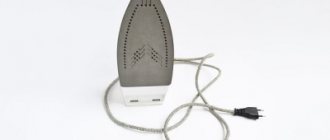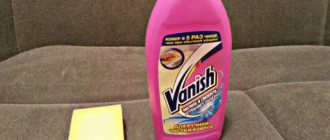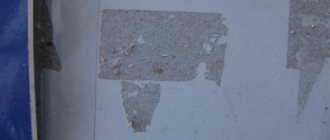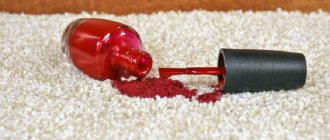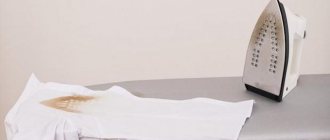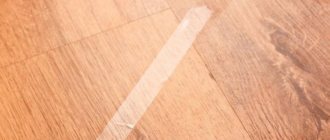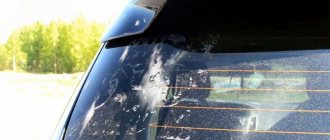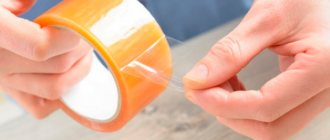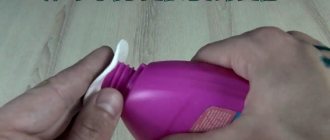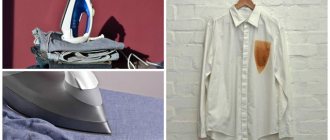Adhesive plaster can be found in almost every first aid kit. In some cases, it is very helpful: when you need to close a callus on your foot, attach a piece of cotton wool or a bandage with a medicinal substance to the wound. It also leaves characteristic stains that are difficult to remove. In the manufacture of both adhesive tape and adhesive plaster, various components are used that are difficult to wash off: natural and synthetic rubbers, polymers, oils, fillers and medicinal substances. Of course, you can just wait a little: the stains will come off after several washing procedures. But sometimes it is necessary to get them out as quickly as possible. Then folk recipes will help. There is no clear answer on how to quickly and effectively remove adhesive tape marks on skin and clothing, but there are effective folk methods that can help.
How to Remove Band-Aid Stains from Baby Skin
Children's epidermis is very vulnerable, exposure to any means will lead to bad consequences: burns, rashes, irritations, etc. For this reason, when choosing a product for removing adhesive from a patch from a child's skin, the composition and its effect are taken into account. First, the patch is painlessly removed, and then the glue is washed off. If one method fails, you should not immediately use the second; the skin should rest.
Vodka
Vodka has a more gentle effect on the baby's skin than alcohol, but it is not safe. When it gets into a wound, it causes severe burning and redness. Using such material, you must carefully carry out the procedure for washing off the glue:
- take ready-made vodka or dilute alcohol in a 1:1 ratio;
- Gently apply a finger moistened with vodka in places where glue accumulates, avoid getting it into the wound;
- After a few minutes, wipe with a paper napkin;
- lubricate with baby cream.
If redness appears at the treatment site, rinse with running water and apply antiallergic ointment.
Vegetable oil
Vegetable oils can affect glue, which, in turn, loses their stickiness or completely dissolves over time.
The use of baby and vegetable oils is safest for children's skin. Oils specially designed for children's skin will cope with the removal of adhesive painlessly and with beneficial effects. But ordinary vegetable oils (olive, corn, sunflower) will perform the task just as well. For the procedure you will need: bandage or cotton wool, vegetable oil, wet wipe.
Sequencing:
- moisten the bandage with oil (a small amount is enough, otherwise it will start spreading over the skin);
- apply to the child’s skin in the area where the glue accumulates;
- wait 15 minutes;
- Remove everything with a damp cloth.
This process is safe and can be done many times. To make the procedure interesting for children and not be capricious, you can add food pigment to the oil, which will color the glue. Thus, the oil will get rid of the problem and distract the child from a boring procedure.
Handy tools for removing glue
This section provides 3 most inexpensive methods that do not require the purchase of additional tools and accessories.
- Warm bath (or soak). As practice shows, many plasters lose their strength when exposed to moisture and heat. Therefore, the easiest way is water procedures. To do this, you don’t have to soak in the bathroom for 5 hours, just fill a basin with warm water and dip the part of your body from which you need to peel off the annoying adhesive plaster. For the best effect, you can rub your body with light movements of your hand and a washcloth.
- Vegetable oil. Thanks to many tests carried out, a result was noticed in which, from exposure to any vegetable oil, the patches lost their stickiness, and sometimes the adhesive composition simply dissolved in it. You just need to soak a cotton swab in oil, apply it to the surface of the patch and wait 10-15 minutes. Then you will need to wipe the skin area with a napkin and, if necessary, repeat the procedure again.
- Ice. If you are going to wipe off the adhesive from your child's skin, it is better not to use this method. People with hypersensitive skin should also avoid it. Of course, using ice will not lead to any side effects; it’s just that the above categories of people have a chance of getting irritated or causing dry skin. To clean your skin with ice, just wrap it in a paper towel and apply it to the desired area. After waiting a few minutes, remove the cold and remove the sticker or any remaining sticker.
Peeling methods
If the patch is small, it is important to remember that the movement when removing should be sharp. You can hold the loose skin with one hand.
Now let's look at the basic methods that will help you remove the patch painlessly. There are several of them, and they are all quite effective. So, if you cannot remove the patch dry, you can do this using the following means:
- Water.
Many people have probably noticed that, once under water, the patch comes off easily. This is because water has a weakening effect on the glue. You should carefully wet the adhesive part or apply a damp compress. However, it is necessary to remember that there are some other patches, the soaking of which is contraindicated.
- Vaseline or baby oil, soap or moisturizing lotion.
These substances can weaken the strength of the glue. To do this, you can apply a greasy substance to the area of the sticky part and rub in with massaging movements until the patch begins to come off easily. Vaseline or baby oil can be left on for about 15 minutes for better effectiveness. Another method is to slightly bend the edge of the adhesive base and apply a few drops of lotion or oil between it and the skin.
- Alcohol.
Alcohol is a good solvent, including for glue. The method of application is similar to the previous one. It is necessary to slightly unscrew the edge and gently lubricate the skin with alcohol. Another method is to apply a cotton pad soaked in alcohol to the adhesive ends. By the way, this product is also used to remove traces of glue from the skin.
- Heating.
Some people recommend removing the patch by heating it, such as using a hair dryer. By directing streams of hot air at the adhesive part, it is possible to melt the glue. However, if the skin is too sensitive, this removal method will not work.
For some, removing the patch does not cause discomfort or discomfort. But children and people with sensitive skin and a low pain threshold may find it difficult to tolerate this procedure. But there is a way out of any difficult situation. And in this case, following the above rules, you can peel off the patch without experiencing pain.
protdt.ru
Subtleties of removing the patch in animals
I would also like to talk about how to remove the patch from a dog’s ears, because very often many owners face this problem after ear cropping, the process of giving the desired shape to the cartilage, or as a result of surgery. Each animal has a covering of wool, to which adhesive products stick no less strongly than to human hair. Thus, the tightened cover gives the animal discomfort and restricts freedom of movement, like a cage from which you want to get rid of it as quickly as possible.
You can free the dog's ear from the patch using the same scheme that works with a person. But very often, in order not to bother, many dog owners free the ear by cutting off the hair on it. Of course, it grows back over time, but why torture an animal when there are more humane methods?
As practice shows, for some people it is not difficult to remove the patch: they jerk the product sharply, remove it and forget about it. But for a child and people with sensitive skin or a low pain threshold, this is a whole problem, which is accompanied by unpleasant discomfort and subsequent irritation. But, as our article proves, you can find a way out of any situation, and by following our simple tips, you will not feel pain.
An adhesive plaster is an indispensable thing in everyday life and medicine. And everything would be fine, but its adhesive base sticks quite firmly to the skin. Peel off the patch
“dry” is very painful, so it is recommended to soak the fabric-based glue first: with medical alcohol, olive oil, baby massage oil or warm water. If there was nothing at hand and you had to peel off the patch
“dry”, do it sharply, in one movement. Then it will sting, but this will make the torture easier for yourself. Down with blasphemous methods, let’s soak it off. So…
INSTRUCTIONS FOR USE OF KINESIO TAPES
There are some instructions for applying kinesio tape that cannot be ignored in order to avoid allergic reactions and incorrect operation of the patch. First, you need to clean the area where the patch will be applied. For maximum fixation of kinesio tape, degrease the skin and, if necessary, remove thick hair. Also, do not apply tape to damaged areas of the skin (cuts, scratches).
This is the only way to safely remove the tape!
The most important step is to apply kinesio tape to the skin. First you need to round the edges of the tape : this will allow it to stay on the skin longer. You can use any sharp household scissors. The next step is the "anchor". these are the first few centimeters of tape . which must be applied without tension. To avoid wrinkles on the adhesive base of the tape , first lightly rub the area of skin on which the tape will be applied. The same thing needs to be done after gluing - the tape should be rubbed. If at first you feel a slight itch, do not worry: the skin receptors excited by the glue will gradually get used to the kinesio tape.
After 2-4 independent applications, you will be able to easily handle the kinesio tape. To reinforce the material, let’s repeat the basic rules:
- Do not perform exercises for the first 20 minutes after fixation;
- Degrease the application area;
- If necessary, remove excess hair;
- To activate the glue, rub the sports tape after application;
- Be sure to round the edges;
- the first 3-5 cm of tape (anchor) without tension;
Subtleties of removing the patch in animals
I would also like to talk about how to remove the patch from a dog’s ears, because very often many owners face this problem after ear cropping, the process of giving the desired shape to the cartilage, or as a result of surgery. Each animal has a covering of wool, to which adhesive products stick no less strongly than to human hair. Thus, the tightened cover gives the animal discomfort and restricts freedom of movement, like a cage from which you want to get rid of it as quickly as possible.
You can free the dog's ear from the patch using the same scheme that works with a person. But very often, in order not to bother, many dog owners free the ear by cutting off the hair on it. Of course, it grows back over time, but why torture an animal when there are more humane methods?
As practice shows, for some people it is not difficult to remove the patch: they jerk the product sharply, remove it and forget about it. But for a child and people with sensitive skin or a low pain threshold, this is a whole problem, which is accompanied by unpleasant discomfort and subsequent irritation. But, as our article proves, you can find a way out of any situation, and by following our simple tips, you will not feel pain.
INSTRUCTIONS HOW TO REMOVE KINESIO TAPE
It is a misconception that kinesio tape needs to be wetted with water before removal. Don't forget about the water resistance of the adhesive base. If the tape patch is wet or abruptly torn off, the epidermis can be damaged.
tape remover spray and master a simple technique. The first option is suitable for children, the elderly and those with very sensitive skin. The second option is suitable for everyone else: grab the edge of the kinesio tape , and press the tape flat with the index finger of your other hand. Slowly pull the tape from top to bottom, sliding the pressed finger of your second hand directly under the outgoing part of the kinesio tape .
- Do not pull the kinesio tape, otherwise you may damage the top layer of skin and get irritated. If you do do this, rinse your skin with water and apply cream.
- Do not wet the kinesio tape with water before removing it. You will damage the epidermis.
READ How to remove price tag glue from plastic
How to apply a bandage correctly so that the bandage does not stick
To prevent the risk of ingrown dressing material that may stick, you should follow some simple rules for applying a dressing and treating a wound:
- compliance with the rules of asepsis and antiseptics eliminates the risk of suppuration, impregnation with pus, and adhesion to the skin;
- if the wound is small, do not immediately bandage it; it must be treated with an antiseptic and allowed to dry to prevent tissue adhesion;
- after treatment with an antiseptic, you can apply an ointment - it will create a barrier, soften the area, absorb intercellular fluid, and prevent the risk of the gauze or bandage drying out;
- Do not apply lint-like materials to wet wounds, as this increases the risk of particles that may stick to the wound.
If you have difficulty peeling off the bandage, you should seek medical help to prevent re-damage, prevent infection, and speed up wound healing. The article has been verified by the editors
Reason for bandage sticking
Among the provoking factors that serve as the root cause of ingrowth or adhesion of dressings are:
- The natural process of secreting intercellular fluid for wound healing (blood and “ichor”). Soaking gauze or cotton wool causes the dressing to dry to the crust.
- Initially, improper treatment of the damaged area using alcohol and alcohol-containing antiseptics creates initial dryness and activation of compensatory mechanisms for fluid secretion.
- Incorrect application of sterile material to the wound. With a pressure bandage that interferes with normal blood circulation and lymphatic drainage, stagnation occurs in the intercellular space with swelling of the surface and sticking of the bandage.
- The use of loose tissue, particles of which can penetrate into the affected area, is soldered during the healing process, which creates further difficulties - you have to peel off the tourniquet from the wound.
- The presence of extensive adhesion and inflammation with the addition of a secondary infection, complications with the formation of pus, and penetration of pyogenic effusion into the tissue over the wound.
- Hard to reach places
What happens if you don't shoot?
If you do not remove a bandage that is stuck and do not try to peel it off the wound, two complications may develop:
- The cellular mechanisms of immune defense gradually push the foreign material out during the healing process, the bandage along with the crust will fall off, and the damage will heal naturally.
- With deep wounds, the adherent area can become overgrown with granulations, which requires surgical intervention and causes complications in the form of an inflammatory reaction and suppuration of soft tissues.
